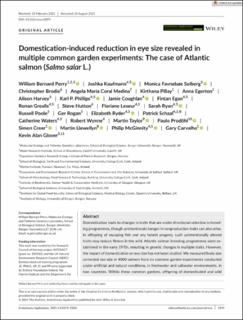Domestication-induced reduction in eye size revealed in multiple common garden experiments: The case of Atlantic salmon (Salmo salar L.)
Perry, William Bernard; Kaufmann, Joshka; Solberg, Monica Favnebøe; Brodie, Christopher; Coral Medina, Angela Maria; Pillay, Kirthana; Egerton, Anna; Harvey, Alison C.; Phillips, Karl P.; Coughlan, Jamie; Egan, Fintan; Grealis, Ronan; Hutton, Steve; Leseur, Floriane; Ryan, Sarah; Poole, Russell; Rogan, Gerard; Ryder, Elizabeth; Schaal, Patrick; Waters, Catherine; Wynne, Robert; Taylor, Martin I.; Prodöhl, Paulo; Creer, Simon; Llewellyn, Martin; McGinnity, Philip; Carvalho, Gary R.; Glover, Kevin Alan
Peer reviewed, Journal article
Published version
Permanent lenke
https://hdl.handle.net/11250/2825885Utgivelsesdato
2021Metadata
Vis full innførselSamlinger
- Articles [3012]
- Publikasjoner fra CRIStin [3070]
Sammendrag
Domestication leads to changes in traits that are under directional selection in breeding programmes, though unintentional changes in nonproduction traits can also arise. In offspring of escaping fish and any hybrid progeny, such unintentionally altered traits may reduce fitness in the wild. Atlantic salmon breeding programmes were established in the early 1970s, resulting in genetic changes in multiple traits. However, the impact of domestication on eye size has not been studied. We measured body size corrected eye size in 4000 salmon from six common garden experiments conducted under artificial and natural conditions, in freshwater and saltwater environments, in two countries. Within these common gardens, offspring of domesticated and wild parents were crossed to produce 11 strains, with varying genetic backgrounds (wild, domesticated, F1 hybrids, F2 hybrids and backcrosses). Size-adjusted eye size was influenced by both genetic and environmental factors. Domesticated fish reared under artificial conditions had smaller adjusted eye size when compared to wild fish reared under identical conditions, in both the freshwater and marine environments, and in both Irish and Norwegian experiments. However, in parr that had been introduced into a river environment shortly after hatching and sampled at the end of their first summer, differences in adjusted eye size observed among genetic groups were of a reduced magnitude and were nonsignificant in 2-year-old sea migrating smolts sampled in the river immediately prior to sea entry. Collectively, our findings could suggest that where natural selection is present, individuals with reduced eye size are maladapted and consequently have reduced fitness, building on our understanding of the mechanisms that underlie a well-documented reduction in the fitness of the progeny of domesticated salmon, including hybrid progeny, in the wild.
